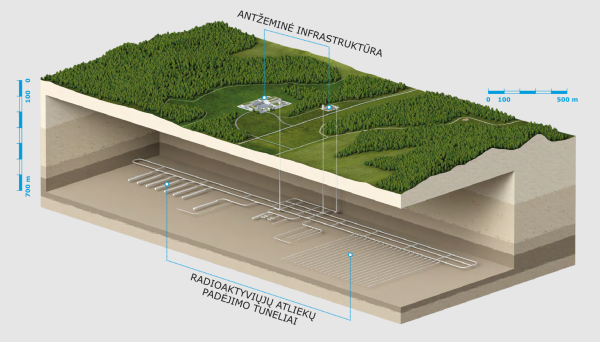Deep geological repository – Lithuania’s commitment to national security
2024

In 2020, Lithuania started planning for the construction of the deep geological repository project to provide final disposal of spent nuclear fuel and long-living radioactive waste from the operation of the Ignalina Nuclear Power Plant (INPP). The initial phase of the project is now underway – studies are performed to select a site for the deep geological repository. To date, 77 potential sites have been identified in 29 Lithuanian municipalities, which will be subject to a wide range of studies and evaluations until 2047. Only after complex and detailed studies and public consultation will a final site for the deep geological repository be selected in 2047, and built in 2067.
Assessment by international experts
Last July, experts from the International Atomic Energy Agency (IAEA) visited Lithuania and concluded that the deep geological repository project is being carried out in compliance with environmental and public safety requirements. The experts commended Lithuania for its early development and implementation of the programme, and welcomed the country’s initiative to start the site selection process on time, as well as for its active planning of the next steps of the project.
The importance and safety of the deep geological repository
When Lithuania was preparing to join the EU and NATO, a National Energy Strategy was approved and adopted, committing to the closure of the INPP and the final management of radioactive waste after its closure.
Following the experience of the global nuclear energy community, examples of radioactive waste management in other countries and the recommendations of the IAEA, Lithuania has enshrined in its legislation that the only sustainable way of final management of spent fuel and high-level radioactive waste is to place it in the deep geological repository.
Currently, spent fuel and long-lived radioactive waste are stored in above-ground interim storage facilities, which are designed for a minimum lifetime of 50 years. At the end of the lifetime of these storage facilities, the long-lived radioactive waste, after final treatment, will have to be transferred to the deep geological repository.
The deep geological repository is an engineering structure planned to be built several hundred metres underground. It will be used to isolate long-lived radioactive waste generated during the operation of the INPP. The deep geological repository will provide environmental protection through natural barriers in the form of deep rock formations, as well as additional engineered barriers.
Site selection for a deep geological repository
All potential sites are assessed against the IAEA’s three criteria for generic requirements for the selection of a site for the deep geological repository: long-term safety; technical suitability and operational safety; and socio-economic, political and environmental considerations.
To date, 77 potential sites have been identified in 29 Lithuanian municipalities, which will be subject to a wide range of studies and evaluations until 2047. Only after complex and detailed studies and public consultation will a final site for the deep geological repository be selected.
The IAEA and the international community of nuclear-capable states are unanimous in confirming that an deep geological repository is the only safe long-term option for the final disposal of long-lived radioactive waste.
In the IAEA’s assessment, the geological, socio-economic and safety studies at the initial stage of the site selection process provide a solid basis for further work in the subsequent conceptual design stages.
Out of an initial 110 possible sites, 77 potential sites remain
An independent assessment of the results of the studies found that, based on the ineligibility/rejection criteria, 33 of the originally identified 110 potential deep geological repository sites should be rejected.
The INPP, in cooperation with the Lithuanian Geological Survey, the expert Finnish environmental technology organisation Posiva and the international Spanish engineering and architectural consultants IDOM, carried out studies to assess potential sites in Lithuania according to geological, socio-economic and safety criteria. A total of 31 sites were found to be non-compliant with the stability criteria, as well as criteria related to groundwater, mineral deposits and/or helium anomalies. Two sites were rejected under socio-economic criteria (spatial planning and environmental issues). One site was rejected because it contains Permian rocks that do not meet geological and safety requirements.
The process of selecting the 77 potential sites for 2023 has also been presented and evaluated by the IAEA.
Experts working on the project
The INPP is responsible for the deep geological repository project. A special inter-institutional working group has been set up by order of the Minister of Energy to monitor the implementation of the project. This includes specialists from the Ministries of Energy, Finance, Environment, the State Nuclear Power Safety Inspectorate, the Radiation Protection Centre, the Lithuanian Geological Survey and the INPP. They are all members of the competent authorities involved in monitoring radioactive waste management.
The results of the assessment are submitted to the IAEA for independent peer review. The working group may also call on experts and representatives of other institutions, bodies and organisations as appropriate.
Radioactive waste cannot be imported into Lithuania from other countries
Nuclear waste management is governed by an international convention between the world’s nuclear states. This states that each country is responsible for its own waste, without the right to transfer it to other states. Therefore, to ship radioactive waste elsewhere, not only Lithuanian law, but also international conventions and agreements, would have to be amended.
Like all countries in the world, Lithuania prohibits the final management of radioactive waste from other countries on its territory. According to the Law on Radioactive Waste Management of the Republic of Lithuania, it is forbidden to import radioactive waste or spent nuclear fuel into the territory of Lithuania (except when the waste is in transit through the territory of Lithuania).
Project publicity and openness to the public
Information on aspects such as the deep geological repository implementation processes, site selection criteria, assessment process and potential impacts is available publicly. Information is also continuously published on the INPP website and in the media to help raise awareness of the importance and necessity of the project, and how the safety of the repository will be ensured.
Continuous communication with the public is planned throughout the life cycle of the project, so all studies and planned activities for the next phases will continue to be publicised and the resulting reports will be provided for public access. In addition, the results of all phases are to be submitted to an independent international assessment by the IAEA.
A public consultation was held in Vilnius in March this year during which the project, potential sites for the deep geological repository and installation phases were presented to municipal representatives, and questions raised by participants were answered.
Project stages
The stages for the installation of the deep geological repository are described in the Development Programme for the Decommissioning of Nuclear Energy Facilities and Radioactive Waste Management for the period 2021–2030, approved by the Government of the Republic of Lithuania.
The deep geological repository site selection study programme is expected to be completed by 2047. The preliminary schedule indicates that it will be constructed between 2058 and 2067, in operation between 2068 and 2074 and shut down between 2075 and 2079.
The INPP is responsible for the implementation of the deep geological repository project and, together with the Ministry of Energy, coordinates the installation of the repository and periodically updates the schedule of planned works.

